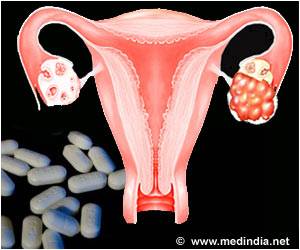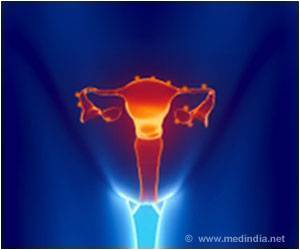Scientists have identified micro RNA 506 (miR-506) as a therapeutic candidate for advanced or metastatic ovarian cancer.

Micro RNAs do not code for genes like their cousins, the messenger RNAs. They are capable of blocking a gene's activation by plugging up its promoter region or altering its protein after it's expressed.
Cell line experiments demonstrated that miR-506 blocks cancer cells by suppressing a protein crucial to transforming a cell from one type to another associated with cancer invasiveness, metastasis and shortened survival.
Analysis of human tumors showed higher miR-506 expression is associated with longer overall survival. Mice with two types of advanced ovarian cancer treated with miR-506 packaged in a fatty (liposomal) nanoparticle had fewer and smaller tumors than control mice.
"We next plan to test whether miR-506 sensitizes ovarian cancer cells to cisplatin (standard chemotherapy) in our mouse model," Zhang said.
The liposomal nanoparticles already have been shown to be safe for human use, said co-senior author Anil Sood, M.D., professor in MD Anderson's Departments of Gynecologic Oncology and Cancer Biology and the Center for RNAi and Non-Coding RNA. "After the additional combination experiments, we would need to do formal safety testing before moving it into clinical trials," Sood said.
Advertisement
New analysis of The Cancer Genome Atlas data Based on gene expression data from 489 high-grade serous ovarian carcinoma patients, TCGA's initial study published in Nature divided these patients into four categories but found no survival differences among the groups.
Advertisement
There are a number of significant differences between the two types of cell. One is mobility: epithelial cells are designed to stay put and are likely to die in a variety of ways if they break away from the primary tumor. Mesenchymal cells can move about. They also rely on distinctive protein biomarkers.
The search narrows, from 2,942 genes to one miRNA The researchers used additional data from the TCGA group - alterations of gene copy number, miRNA expression and DNA methylation, which silences genes - and re-analyzed the 489 patients.
"With those data, we were able to identify a subtype of ovarian cancer, look deeply into the mechanism behind it and identify regulators of that type so we can develop new treatments," said co-lead author Da Yang, Ph.D., an MD Anderson Odyssey Scholar in the pathology department.
Starting with 2,942 genes that TCGA identified as overexpressed in the mesenchymal group, they narrowed that list to 253 genes, 219 of which were associated with miRNA.
They found that the 219 miRNA-associated mesenchymal genes divided 455 ovarian cancer patients into two clusters:
- 171 with high levels of miRNA expression, 169 of whom had high-grade disease, and shorter survival, classified as the mesenchymal subtype.
- 284 with low levels of miRNA gene expression, longer survival and lower grade disease, classified as the epithelial subtype.
The team confirmed these results in three independent data sets totaling 560 ovarian cancer patients.
Nineteen miRNAs were identified, eight of which were predicted to control 89 percent of the 219 miRNA-associated genes. Of the eight, the least was known about miR-506, and it was least expressed in the mesencyhmal cases. "We decided to focus on miR-506," Zhang said.
miR-506 blocks mesenchymal, helps epithelial proteins In a series of cell line experiments, the scientists forced overexpression of miR-506 and a control miRNA in ovarian cancer cells. Treated cells had much lower levels of two important mesenchymal markers and higher levels of E-cadherin, a protein vital to epithelial cells.
Additional experiments showed miR-506 specifically inhibited SNAI2, a mesenchymal-cell-promoting protein, by binding to the promoter region of its gene, blocking activation.
Transforming growth factor beta (TGFß) induces epithelial-to-mesenchymal cell transition, and the team found that it was prominent in the mesenchymal type of ovarian cancer. In cancer cells treated with miR-506 and then treated with TGFß, the miRNA completely abolished TGFß's effects.
In human tumors, more miR-506 tied to improved survival Analysis of 92 ovarian cancer tumors from Tianjin Hospital in Tianjin, China, showed:
- Tumors with low levels of miR-506 had mesenchymal traits, including high levels of SNAI2 and VIM, another mesenchymal biomarker, and low levels of E-cadherin.
- Tumors with high levels of miR-506 had epithelial traits, including more E-cadherin, and less SNAI2 and VIM.
- High miR-506 Tianjin patients had a median survival of 50 months, compared with 30 months for those with low levels.
These results were repeated in two separate data sets of 160 cases.
Zhang and colleagues treated mice with two ovarian cancer cell lines with either nanoparticle miR-506 or a control nanoparticle.
Mice treated with miR-506 not only had fewer (75 and 48 percent declines), smaller tumors (down 78 and 53 percent), they also had steeply reduced levels of SNAI2 and VIM and major boosts of E-cadherin (200 and 120 percent increases).
These results suggest liposomal nanoparticle-delivered miR-506 might be developed as an ovarian cancer treatment. While miRNA has been effective in lab experiments, delivery in liposomal nanoparticles has shown promise in research at MD Anderson and other institutions.
Longstanding collaborations with the Institute for Systems Biology in Seattle, and MD Anderson sister institution Tianjin Medical University are vital to this research, Zhang said.
Source-Eurekalert















